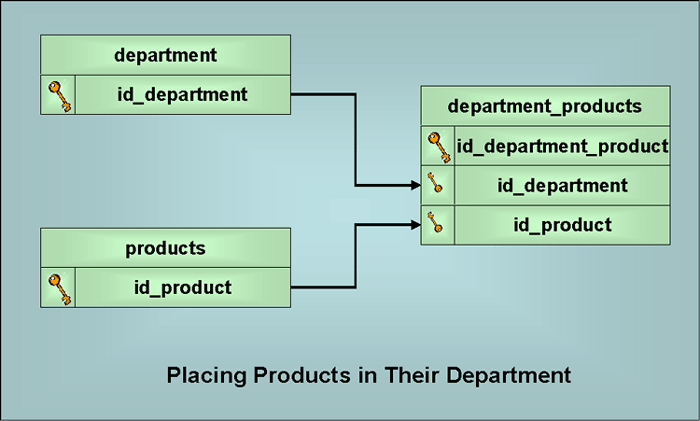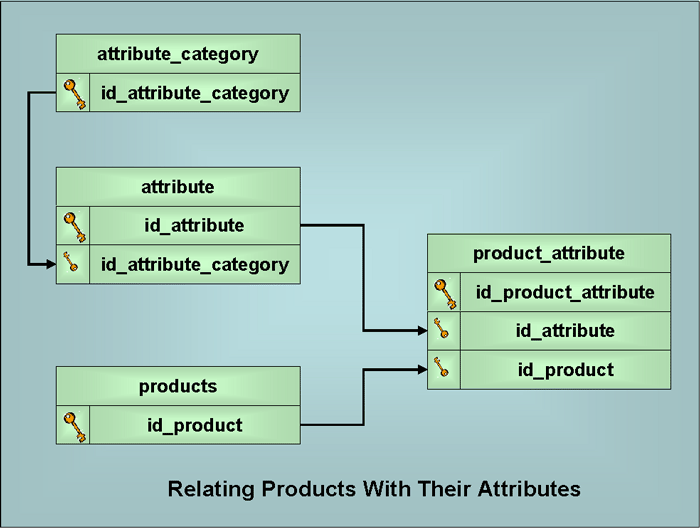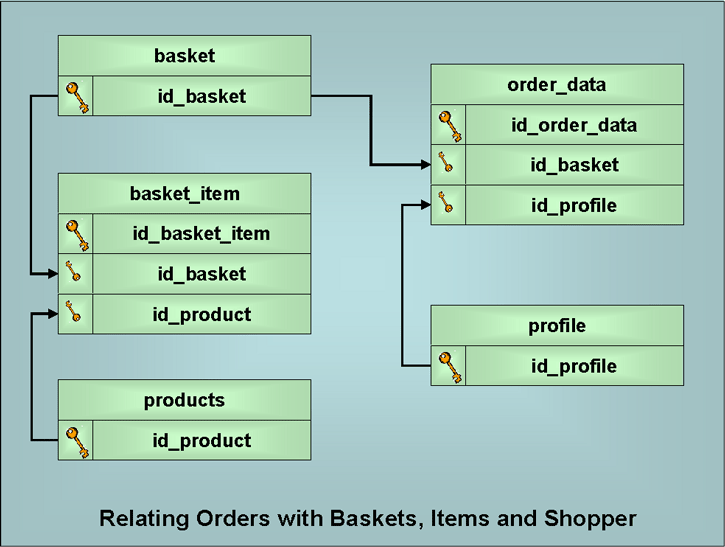| department | |||
| Key | Field | Data Type | Allow Nulls |
|
|
id_department | int | no |
| department_name | varchar | yes | |
| department_description | varchar | yes | |
| department_image | varchar | yes | |
Some Background on the Tables
| Introduction.
While this is definitely beating this issue over the head in many ways, it
is important to determine as much as you reasonably can about the tables
you will use before starting your developments. While, in reality,
it is nearly impossible to do this with total foresight, it is still
important to do this. But, as you should know, since this is
academia and because I have developed these sorts of webs before this
presentation should be quite accurate. Tables. Remember we have several different types of things that we already know we need to consider in our store. In some people's jargon, these are our entities.
Each of these aspects of the ecommerce store require us to develop tables to retain appropriate information. Some other issues/entities we could integrate into our over all functionality are for
Obviously, since this is a semester course we need to limit what sorts of options we consider. But it is hoped that you will learn more than enough within this course to be able to develop these sorts of options. Fields. Now I want to reiterate the preceding outline and include the appropriate fields under the appropriate table. The following list of tables gives the important characteristics of each table required for our database. |
| department | |||
| Key | Field | Data Type | Allow Nulls |
|
|
id_department | int | no |
| department_name | varchar | yes | |
| department_description | varchar | yes | |
| department_image | varchar | yes | |
| products | |||
| Key | Field | Data Type | Allow Nulls |
|
|
id_product | int | no |
| product_name | varchar | yes | |
| product_description | varchar | yes | |
| product_image | varchar | yes | |
| weight | float | yes | |
| price | float | yes | |
| department_products | |||
| Key | Field | Data Type | Allow Nulls |
|
|
id_department_product | int | no |
| id_department | int | yes | |
| id_product | int | yes | |
| The following diagram should help illustrate how
the department_products table can be used to place the products in
an associated department. Notice how the keys within a table
are used to identify particular departments and products as foreign
keys within the department_products table. I have rotated and reduced the key symbol to represent a foreign key. |

| Now we start presenting the tables associated with the product attributes. |
| attribute_category | |||
| Key | Field | Data Type | Allow Nulls |
|
|
id_attribute_category | int | no |
| category_name | varchar | yes | |
| attribute | |||
| Key | Field | Data Type | Allow Nulls |
|
|
id_attribute | int | no |
| attribute_name | varchar | yes | |
| id_attribute_category | int | yes | |
| product_attribute | |||
| Key | Field | Data Type | Allow Nulls |
|
|
id_product_attribute | int | no |
| id_attribute | int | yes | |
| id_product | int | yes | |
| The following diagram displays how each of the products are assigned their attributes. |

| While we don't truly "need" the following table,
including it will make our queries and code much easier to
structure. If you are wedded to the idea of maintaining a
purely minimalist coverage of our needs with normalized tables, we
will be breaking your rules. Reality is often different than
this, though maintaining this ideal as much as reasonable has its
purposes. Later, when we are developing code to actually display our products dynamically on pages while giving all of the appropriate attributes the customer will select I will discuss why having this additional table is more than convenient. It actually will allow us to nest some loops based on queries much more easily. Though, it should make sense that having a table that directly relates products with their attribute_categories is something we can make use of. This is true even if by database theory we can derive these relationships from other tables, since writing the queries and PHP code will be much more direct and make more sense. |
| product_attribute_category | |||
| Key | Field | Data Type | Allow Nulls |
|
|
id_prod_attribute_category | int | no |
| id_product | int | yes | |
| id_attribute_category | int | yes | |
| First the attribute categories are
developed/named. Some example attribute categories are things
like size, color and flavor. Then the attributes are named and
associated with a particular attribute category in the attribute
table. Then the attributes are associated with the products in
the product attribute table. Notice that while the attributes
are still within a category, not all of the attributes in a category
need to be available to a product that has this particular attribute
category. Now we return to our development of the other tables we will be using by starting on those associated with the shopping basket. We will make use of two common strategies when dealing with the check out experience.
If we didn't retain the credit card information in the shopper's profile, we would need to keep a separate table associated with this, probably in a table called payment_data. Retaining credit card information allows the site to create the sorts of simplified "one button" purchasing experience that most shoppers seem to prefer. But, there are obviously security issues to resolve when a shopper can log on to their profile and readily access their own information. |
| basket | |||
| Key | Field | Data Type | Allow Nulls |
|
|
id_basket | int | no |
| order_placed | int | yes | |
| sub_total | float | yes | |
| total | float | yes | |
| cost_shipping | float | yes | |
| tax | float | yes | |
| date_created | datetime | yes | |
| basket_item | |||
| Key | Field | Data Type | Allow Nulls |
|
|
id_basket_item | int | no |
| id_product | int | yes | |
| price | float | yes | |
| weight | float | yes | |
| product_name | varchar | yes | |
| item_quantity | int | yes | |
| id_basket | int | yes | |
| attribute1 | varchar | yes | |
| attribute2 | varchar | yes | |
| profile | |||
| Key | Field | Data Type | Allow Nulls |
|
|
id_profile | int | no |
| varchar | yes | ||
| password | varchar | yes | |
| bill_first_name | varchar | yes | |
| bill_last_name | varchar | yes | |
| bill_address | varchar | yes | |
| bill_city | varchar | yes | |
| bill_state | varchar | yes | |
| bill_zipcode | varchar | yes | |
| bill_phone | varchar | yes | |
| bill_fax | varchar | yes | |
| ship_first_name | varchar | yes | |
| ship_last_name | varchar | yes | |
| ship_address | varchar | yes | |
| ship_city | varchar | yes | |
| ship_state | varchar | yes | |
| ship_zipcode | varchar | yes | |
| ship_phone | varchar | yes | |
| ship_fax | varchar | yes | |
| card_type | varchar | yes | |
| card_number | varchar | yes | |
| expiration_month | varchar | yes | |
| expiration_year | varchar | yes | |
| card_name | varchar | yes | |
| date_registered | datetime | yes | |
| order_data | |||
| Key | Field | Data Type | Allow Nulls |
|
|
id_order | int | no |
| id_basket | int | yes | |
| varchar | yes | ||
| bill_first_name | varchar | yes | |
| bill_last_name | varchar | yes | |
| bill_address | varchar | yes | |
| bill_city | varchar | yes | |
| bill_state | varchar | yes | |
| bill_zipcode | varchar | yes | |
| bill_phone | varchar | yes | |
| bill_fax | varchar | yes | |
| ship_first_name | varchar | yes | |
| ship_last_name | varchar | yes | |
| ship_address | varchar | yes | |
| ship_city | varchar | yes | |
| ship_state | varchar | yes | |
| ship_zipcode | varchar | yes | |
| ship_phone | varchar | yes | |
| ship_fax | varchar | yes | |
| card_type | varchar | yes | |
| card_number | varchar | yes | |
| expiration_month | varchar | yes | |
| expiration_year | varchar | yes | |
| card_name | varchar | yes | |
| date_ordered | datetime | yes | |
| The following diagram illustrates how the keys
and foreign keys are used in each table to relate the order_data
back to the shopper via their profile and their current shopping
basket. It also shows how the basket is built from the
basket_items which are related back to the information about
individual products. We will develop our code so that it allows for a user to override some information such as the shipping address for an order without updating their profile. |

| Our next table relates to the status of an order. It makes use of only the id_order from the order_data table to refer back to its sources. |
| order_status | |||
| Key | Field | Data Type | Allow Nulls |
|
|
id_order_status | int | no |
| id_order | int | yes | |
| id_stage | int | yes | |
| date_shipped | datetime | yes | |
| date_fulfilled | datetime | yes | |
| date_processed | datetime | yes | |
| notes | varchar | yes | |
| shipping_number | varchar | yes | |
| id_processed | int | yes | |
| Finally, our last two tables are essentially
stand alone information relating to determining shipping costs by
weight and taxes by the state the client lives in. The shipping computations can really get quite a bit more involved considering different sorts of shipping options and locations. We will leave these sorts of issues for courses beyond this course. |
| shipping | |||
| Key | Field | Data Type | Allow Nulls |
|
|
id_ship_interval | int | no |
| lower_limit | float | yes | |
| upper_limit | float | yes | |
| shipping_cost | float | yes | |
| taxes_state | |||
| Key | Field | Data Type | Allow Nulls |
|
|
id_state | int | no |
| state_name | varchar | yes | |
| state_abbreviation | varchar | yes | |
| tax_rate | float | yes | |